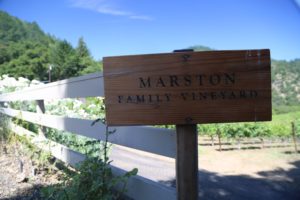
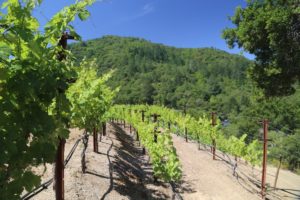
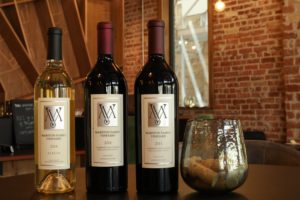 Marston Family Vineyard is located at the very end of White Sulphur Springs Road – west of the town of St. Helena. The drive into the winery property is fantastic; leaving St. Helena one is soon driving on a very narrow windy road which passes what is left of the historic White Sulphur Springs Resort (majority of the buildings burned down in the Glass Fire in 2020). Remarkably, this was a resort for 150+ years and was one of California’s oldest (founded in 1853), but it is no longer open to the public. Visitors who drive by on warm days will be greeted with smells of sulfur for a few minutes (not as bad in the wintertime). The road passes a small creek and winds through some redwoods until reaching Marston’s moss-covered gate before ascending, steeply at times through the Mayacamas mountains up to the vineyard estate. This is the mountain range the divides Napa County from Sonoma County. The views are excellent of the rolling hills, planted vineyards and the valley floor far below.
Marston Family Vineyard is located at the very end of White Sulphur Springs Road – west of the town of St. Helena. The drive into the winery property is fantastic; leaving St. Helena one is soon driving on a very narrow windy road which passes what is left of the historic White Sulphur Springs Resort (majority of the buildings burned down in the Glass Fire in 2020). Remarkably, this was a resort for 150+ years and was one of California’s oldest (founded in 1853), but it is no longer open to the public. Visitors who drive by on warm days will be greeted with smells of sulfur for a few minutes (not as bad in the wintertime). The road passes a small creek and winds through some redwoods until reaching Marston’s moss-covered gate before ascending, steeply at times through the Mayacamas mountains up to the vineyard estate. This is the mountain range the divides Napa County from Sonoma County. The views are excellent of the rolling hills, planted vineyards and the valley floor far below.
History of grapes on the property dates back to the late 1890s when access to the vineyard was on an old Wells Fargo Stagecoach Road which extended all the way to Santa Rosa. The early vineyard plantings were done with horse and plow by the Kramm family.
The well-known and accomplished actor, Clark Gable used to visit frequently. He was good friends and the best man at the wedding of the wineries’ post World War II owner, Al Menasco, a Los Angeles born and raised aviation pioneer in his own right. After World War I Al founded Menasco Motors Company and later developed a revolutionary engine for planes – subsequently releasing a number of models known as “Menasco engines” (some of which are housed at the Smithsonian) and were collectively known as the ‘ inverted, in-line, air-cooled engine’. Al left the company by 1938 and the operations were later sold to Colt Industries with the Menasco name living on in manufacturing in one way or the other until the 1990s. According to an article in the Napa Register dated July 12, 1955, he purchased what is now the Marston Estate in 1949.
Clark Gable actually spent one of his honeymoons (married to Kay Spreckels) in the main house on the property in 1955, although he had visited the property a number of times before. And when Gable was in town, Menasco would sometimes bring him down to the old El Real Cafe in Rutherford for dinner. There weren’t many culinary choices in Napa Valley back then – the Miramonte Hotel and Restaurant in St. Helena was another mid-valley option.
Spreckel’s marriage to Gable was her last; she was married three times previously including to Adolph Bernard Spreckels II, part of the who made their fortune from sugar. The Spreckel’s estate was located south of the city of Napa.
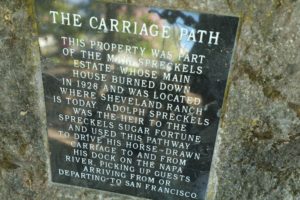 Michael (an urban economist) and Alexandra Marston purchased this property in 1969 from Al (who by this time was in his early 70s although would live until 91 when he passed in 1988) with several other investors including John Wright who was instrumental in launching Domain Chandon and who later owned Kittyhawk Vineyards on Mt. Veeder with his brother. Remarkably, some grapes were still growing at that time dating back to the original plantings in the 1890s (Grenache, Alicante Bouschet & more recent plantings of Pinot Blanc among others). Initially the Marstons were planning on a short-term investment – but by 1976 the Marston’s had purchased the interests of the other partners and were the sole owners. Along with Fritz Maytag of York Creek Vineyards, Michael was an early supporter of creating the Spring Mountain District (AVA), created in 1993.
Michael (an urban economist) and Alexandra Marston purchased this property in 1969 from Al (who by this time was in his early 70s although would live until 91 when he passed in 1988) with several other investors including John Wright who was instrumental in launching Domain Chandon and who later owned Kittyhawk Vineyards on Mt. Veeder with his brother. Remarkably, some grapes were still growing at that time dating back to the original plantings in the 1890s (Grenache, Alicante Bouschet & more recent plantings of Pinot Blanc among others). Initially the Marstons were planning on a short-term investment – but by 1976 the Marston’s had purchased the interests of the other partners and were the sole owners. Along with Fritz Maytag of York Creek Vineyards, Michael was an early supporter of creating the Spring Mountain District (AVA), created in 1993.
An existing winery had been built in the early 1970s as part of the original ownership including the Marstons; the site was known as Lyncrest Vineyard (named for managing partner Dick Lynn). They produced small lots of wine from estate grown fruit but also purchased grapes from select other vineyards. John Henderson was the winemaker for at least the 1974 vintage – he was also one of Conn Creek Vineyard’s early winemakers. Ultimately Lyncrest closed down in 1974 (the last year of production) with their remaining wines liquidated at auction due to bankruptcy. It was at this auction that Conn Creek Vineyards purchased both winemaking equipment and a lot of wines created at Lyncrest Vineyard but were never bottled. Two such lots were a 1973 Steltzner Vineyard Cabernet Sauvignon and a 1974 Cabernet Sauvignon from the iconic Eisele Vineyard in Calistoga. Conn Creek bottled these as their first and second ever releases before their own young vineyards were yet mature. Unfortunately, the old winery building burned down in the Glass Fire in 2020.
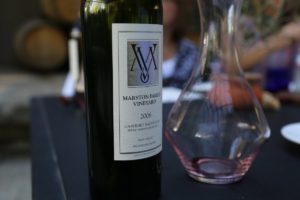
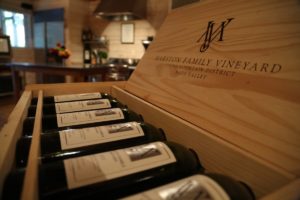
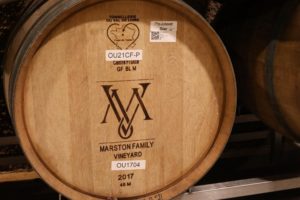 Until the late 1990s, Marston sold their grapes to other wineries including Beringer who currently manages their estate vineyards. Long time and very talented Napa winemaker Philip Togni helped craft wine from the estate from their first vintage in 1982 through 1986 as did winemaker and soils expert André Tchelistcheff. No wines were made from 1987 through 1997; beginning in 1998 Marston Family Vineyard has produced a vintage every year.
Until the late 1990s, Marston sold their grapes to other wineries including Beringer who currently manages their estate vineyards. Long time and very talented Napa winemaker Philip Togni helped craft wine from the estate from their first vintage in 1982 through 1986 as did winemaker and soils expert André Tchelistcheff. No wines were made from 1987 through 1997; beginning in 1998 Marston Family Vineyard has produced a vintage every year.
The Marston’s daughter Elizabeth and her brother John are the current owners of the property and oversee the vineyard and winery operations. Elizabeth has made valuable contributions to Napa’s wine industry having co-founded NG: The Next Generation in Wine in 2006, with a goal to collaborate and promote wines through tastings and events for Napa Valley based wineries overseen by the ‘next generation’.
Elizabeth is also an experienced archaeologist having spent significant time in Greece and Egypt. In 2020, she cofounded Sotera, a powerful AI engine which helps identify the origin of antiquities and provides information if they have been looted.
The Marstons have only 10% of the entire 400-acre estate planted to vine, with much of the surrounding hillsides covered with native vegetation. In 1984/1985 they donated 220 acres of their property to the Napa Land Trust to remain undeveloped as it is (no vineyards, no buildings). The property ranges in elevation from around 800 to 1300 feet.
Marston is known for their hand crafted and balanced Cabernet Sauvignon and there is a reason for this. Combine world class hillside terroir, an exacting attention to detail in the vineyard (we’ve heard their vineyard manager speak of what goes on in the “fields” and it is extensive), and top winemaking skills and one has a valuable wine recipe for success.
Select Wines
The total annual production of the Marston Estate wine is generally between 500 and 1000 cases; their flagship wines is a 100% Cabernet Sauvignon. A more recent addition to the portfolio is Albion, a Sauvignon Blanc initially sourced from Yountville and a Petite Sirah.
The 2018 Albion Sauvignon Blanc is medium gold in color; offers elegant aromas of honeysuckle, citrus blossom, dried straw, a lemon/lime zest and as the bouquet continues to evolve in the glass, shows notes of jasmine. Bright, balanced and lively across the palate, lingers with flavors of lemon meringue and lime. This wine is supported by excellent acidity and minerality. We tasted this about 4 years post vintage date. This wine is 100% varietal. And our vintage notes about the 2013 bottling of Albion were included in a Robb Report article titled, Six of Napa’s Hidden-Gem White and Rosé Wines.
The 2016 Marston Family Vineyard Cabernet Sauvignon is medium to dark ruby in the glass; the bouquet offers sweet aromatics with both ripe fruit and dessert spices including cinnamon and nutmeg. Also offers aromas of blackberry, prune, dark fig and black licorice. Across the palate, shows blackberry, cherry and black currant complemented by some darker spice notes including hints of white pepper. Offers plenty of layers. Lingers with a long, juicy and mouthwatering finish with flavors of cherry and dark currant. The tannins are youthful and finish slightly dry. This wine was fermented both in barrel (40%) and stainless-steel tank (60%). Post fermentation it was aged in French oak barrels for 20 months.
The 2013 Marston Family Vineyard Cabernet Sauvignon is dark ruby in color; while smelling the bouquet, we immediately wrote warm and comforting to describe its aromatic profile. It offers richly layered dark and opulent aromatics of both primary fruit and secondary influences from its barrel aging. We noted ripe blackberry, boysenberry and dark plum along with notes of leather, brown baking spices, molasses and dried herbs. Juicy across the palate, this wine shows excellent vigor 9 years post vintage at the time of our tasting. Mirroring the richness of fruit shown on the bouquet are the depth of flavors including bramble and dark cherry. It lingers savory with short lasting but gripping earthy tannins and a lingering touch of dried tobacco leaf and crushed pepper. This is a beautiful wine that has not yet peaked.
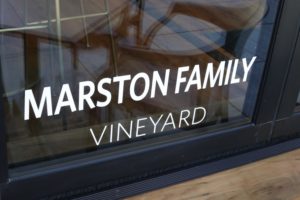
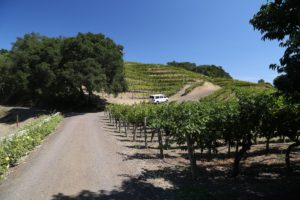
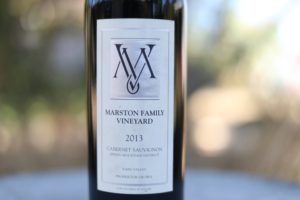 The 2011 Marston Family Vineyard Cabernet Sauvignon (tasted 11 years post vintage date) is dark ruby in the glass; the bouquet is sweet with aromas of dark cherry liqueur, ripe plum, cassis and black currant. As the bouquet breathes offers a hint of dried tobacco leaf but both aromatically and on the palate, this wine does not reflect the much cooler vintage from the 2011 growing season. The palate is juicy and mouthwatering, especially on the finish with flavors of plum and red licorice. The taste and tannin profile seem to indicate a much younger wine. It has held up very well and still has plenty of life ahead. The tannins are not robust but show a noticeable long-lasting grip.
The 2011 Marston Family Vineyard Cabernet Sauvignon (tasted 11 years post vintage date) is dark ruby in the glass; the bouquet is sweet with aromas of dark cherry liqueur, ripe plum, cassis and black currant. As the bouquet breathes offers a hint of dried tobacco leaf but both aromatically and on the palate, this wine does not reflect the much cooler vintage from the 2011 growing season. The palate is juicy and mouthwatering, especially on the finish with flavors of plum and red licorice. The taste and tannin profile seem to indicate a much younger wine. It has held up very well and still has plenty of life ahead. The tannins are not robust but show a noticeable long-lasting grip.
The 2009 Marston Vineyard Cabernet Sauvignon is dark ruby in color with some brickening of the color due to its age; we tasted this bottling 13 years post vintage. The bouquet reveals aromas of dark cherry, blackberry, old leather, dried herbs and some pretty secondary baking spice aromatics including of espresso, cinnamon stick and mocha. This vintage shows higher acid than some of the earlier Marston bottlings we have tried. The palate offers flavors of red cherry, currant and cranberry. It is juicy and mouthwatering from the entry through to the finish. This wine lingers with a tartness of higher-toned red fruits along with light to medium structured drying tannins and a persistent note of dried tobacco leaf. This is an elegant, food friendly and age-worthy wine.
The 2005 Marston Vineyard Cabernet Sauvignon is even smoother than the 2004 although it is still very full bodied. The bouquet offers floral characteristics with nuances of berry fruit, cocoa and chocolate appearing as it continues to open. Rich ripe fruit dominates the palate, this wine pairs extremely well with food. In 2005 the wine-making program was changed so that the wine was aged in 400-liter puncheons (larger sized then normal wine barrels) custom made in France. These are rotated each day during the fermentation, rather than doing the standard punch-downs. The philosophy with this is turning the barrel allows the wine to receive less agitation than punch-downs. Once fermentation is complete, the wine is removed, pressed and then put back into the same puncheons for its aging. Marston’s philosophy is to ensure the fermentation goes smoothly but with minimal intervention. It is always a challenge to tame mountain grown tannins and the 2005 vintage is a clear reflection of how successfully they were able to do this.
The 2004 Marston Family Vineyard Cabernet Sauvignon is a very dark inky wine. The aromas are initially almost gravelly and as it opens up reveals additional minerality notes and fruit including blackberry. The mouth feel is soft, well balanced and tantalizingly smooth with well-integrated tannins on the finish. It is extremely drinkable now, yet has bright fruit, lively acidity and structure to ensure that this wine will age successfully for a number of years.
—
Through the 2009 vintage, their wine maker was Philippe Melka, a consulting winemaker who works with premium mostly Napa hillside sites and small brands. Philippe was honored as American Winemaker of the year by Robert Parker in Food & Wine Magazine. Marston was fortunate to acquire his services fairly early in his career as currently his time is much sought after. Philippe has a Geology degree (he knows his Napa terroir very well) and loves working with Napa hillside vineyards. As he mentioned to us during one of our earlier visits to Marston Estate, “hillside vineyards are more of a challenge”!
It is always a fine line to craft wines with that special elegance and softness ready to be consumed now, while at the same time ensuring the wine has the acidity, fruit and structure to be aged and not be on the downhill … in say 10 years. This is a line that Philippe walks well; Marston’s older vintages if you can find them, are drinking very well now.
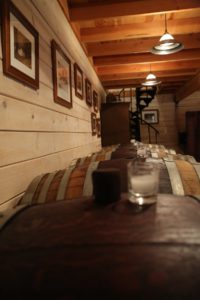
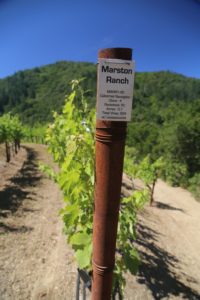 Today their winemaker is Marbue Marke – Marbue is a talented winemaker and is one of the few African American winemakers in Napa Valley. He was born in Sierra Leone, West Africa. During one of our visits with Marbue, he told us the abbreviated story of how he became a winemaker; while studying to get into medical school he soon realized that he tends to faint at the sight of blood. He then pivoted his studies and graduated from the University of California Davis with a degree in Viticulture and Enology.
Today their winemaker is Marbue Marke – Marbue is a talented winemaker and is one of the few African American winemakers in Napa Valley. He was born in Sierra Leone, West Africa. During one of our visits with Marbue, he told us the abbreviated story of how he became a winemaker; while studying to get into medical school he soon realized that he tends to faint at the sight of blood. He then pivoted his studies and graduated from the University of California Davis with a degree in Viticulture and Enology.
Marston’s wines are available through their mailing list, select restaurants and retail stores. One year, their wine was voted the top ranked Cabernet Sauvignon by Wine News Magazine. You can also sometimes find their wines at Gary’s in St. Helena.
Tragically the Glass fire of 2020 burned much of this part of Spring Mountain including destroying most of White Sulphur Springs Resort (sparing two buildings, the Carriage House and the main office) and also destroyed the old winery and accompanying building on the Marston property. For several years Marston Family maintained an office and lounge on Oak Ave but vacated this in 2021. As of our latest update to this review, select tastings for mailing list members are held at the pool house on the property.
Tastings on the property are often (but not always) with proprietor Elizabeth Marston or her husband James and usually last at least 90 minutes.
Mia Carta Napa Valley
For a short while, Marston Family Vineyard was part of a small collective of boutique Napa Valley based wineries represented at Mia Carta Wine Lounge in downtown Napa. While Marston Family wines are no longer available at this space, we keep our notes here for historical reference. This space is located at 1209 1st Street next to Rebel Vintners near the intersection of 1st and Coombs Streets. It had a soft opening to the public on May 22, 2021, and officially opened on June 17, 2021.
This space also houses several other premium boutique Napa Valley producers including Earthshine, Essere Franco, Majuscule and McKahan. Previous wine brand occupants included Arthouse Wines, Ilsley Vineyards, Pellet Estate, Rarecat and Redmon Wines. Sharon Harris, proprietor of Rarecat learned about the space early on, and then invited several of her friends to join including Redmon Wines and Ilsley Vineyards.
A significant amount of thought and effort went into the renovation of this space. A couple of items inside quickly catch one’s eye including the Italian Piaggio “Ape del Vino” or in English, referred to as the Wine Bee. It was purchased in Italy, restored and then shipped over, however unfortunately it was stuck for quite some time at the port of Galveston in Texas before it cleared customs and reached Napa Valley. It is fully functional and is operated by a two-stroke Vespa engine. The back opens up to reveal wine kegs with spigots on the side of the vehicle – making this ideal to take to various wine tasting events. And the 145 piece ‘puzzle’ of walnut wood built against the back wall is in the three-dimensional shape of a street grid of downtown Napa – complete with an outline of Napa River and a red marking to indicate Mia Carta’s location on the map.
Recycled cork from cork manufacturer, Amorim Cork America lines the east wall of the space. If one casually glances at this wall, one will think it’s one entire piece of cork but each piece is a quarter offset, so the lines are hard to see between each of the pieces. With Norm’s background as President & Co-founder of Calgary based ZeroSound Systems, his knowledge and expertise were used during the renovation of the interior space. Acoustic tiles are placed on top of the tin stamped metal ceilings – if one looks carefully one can almost see the tiny holes punched in each of these tin squares, which are part of the design to help mitigate noise. The bar and some of the tabletops are constructed from Richlite, a recycled paper/resin composite.
Visitors taste either inside or outside weather permitting (heat lamps are built into the outdoor overhang), choosing flights from any of the vintners or by the glass or by the bottle. This part of the building used to be recessed – set back more from First Street but during the renovation it was expanded, providing more interior space. And a private tasting room is located in the rear of the space.
For those into wine, it is easy to spend an afternoon in this part of downtown Napa – numerous tasting rooms are within several blocks of Mia Carta. For more details about this beautiful space and or to make a reservation, please visit: www.miacartanapa.com
For more information or to join the Marston Family Vineyard mailing list, please visit: www.marstonfamilyvineyard.com
Vineyards
Original Winery






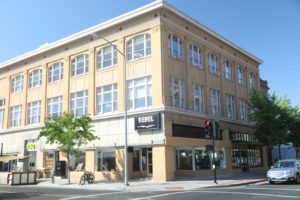
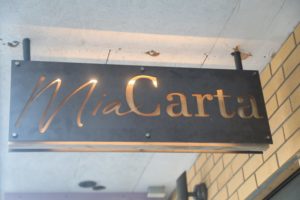
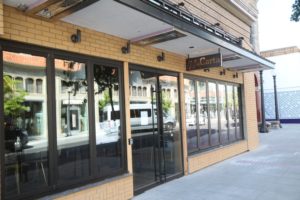
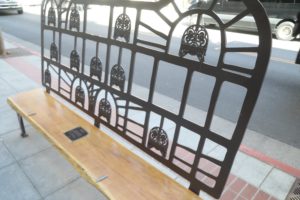
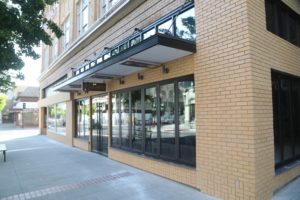
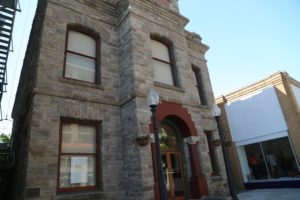

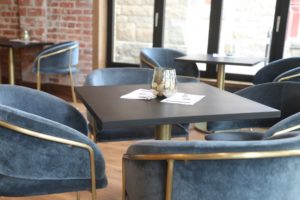
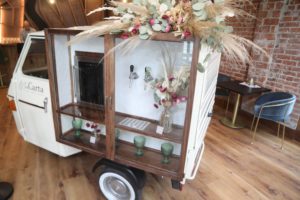
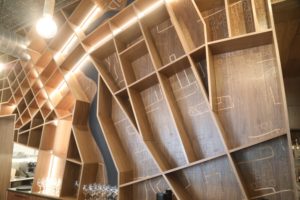
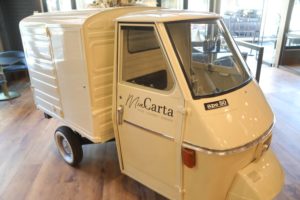
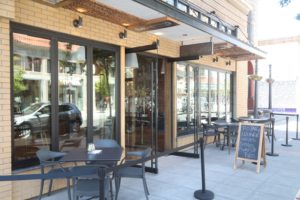
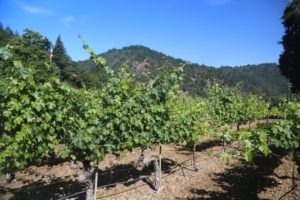
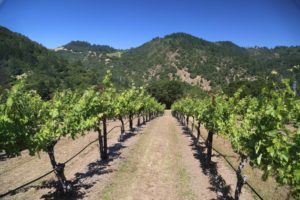
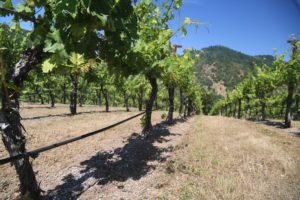
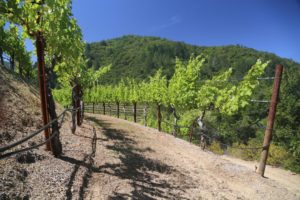
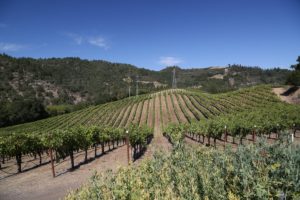
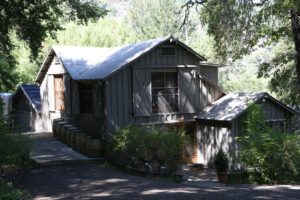
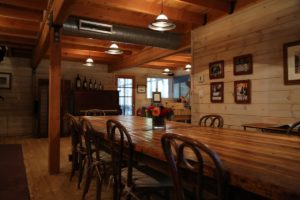
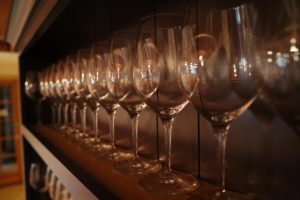
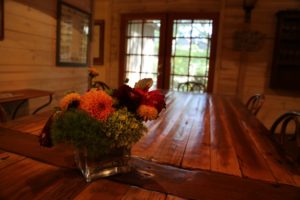
We really miss those special visits up to the property years ago.
So *very sorry* to hear the historic winery burned as did some of the other buildings on the property. Painful. VERY rich history here – what a mess :(((